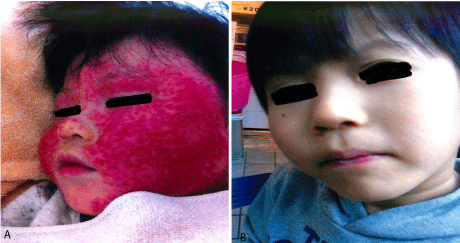Letter to Editor
A Case of Atopic Dermatitis that Healed Virtually Completely after a Number of Intradermal Injections with a Non-Specific Antigen Solution
Kimihiko Okazaki*
Department of Dermatology, Okazaki Medical Clinic, Japan
*Corresponding author: Kimihiko Okazaki, Department of Dermatology, Okazaki Medical Clinic, Ukyoku, Kyoto, Japan
Published: 24 Oct, 2016
Cite this article as: Okazaki K. A Case of Atopic Dermatitis
that Healed Virtually Completely after a
Number of Intradermal Injections with a
Non-Specific Antigen Solution. Ann Clin
Case Rep. 2016; 1: 1161.
Letter to Editor
A 3-year-old boy, who had had an atopic dermatitis since shortly after birth, visited my clinic on October 24, 2012. I started injecting him with 0.1 ml of 10 to the 25 fold-diluted (with saline) Neurotropin, a product of Nippon Pharmaceutical Company, Osaka, Japan, consisting of extract of rabbit skin inflamed with inoculation of Vaccinia virus intradermally alternately on both upper arms at 2~3 day intervals. Immediately after I repeated the injection 38 times, the patient scratched his own body and made the skin condition considerably worse. I started using 0.1 ml of 10 to the 32 fold-diluted Neurotropin to accommodate the worsened skin condition. After I treated the patient with 111th injection with the more diluted solution, he claimed of a worse itchiness and a more erythematous skin color. Then I started using 0.1 ml of 10 to the 36 fold-diluted Neurotropin. After a 20-time repetition of this injection, I started using 0.1 ml of 10 to the 39 fold-diluted Neurotropin because his skin condition became worse again presumably due to increase in the patient’s sensitivity to the injected antigen. After a 7-time repetition of it, the patient’s cheek skin became worse. Then, I started using 0.1 ml of 10 to the 44 fold-diluted Neurotropin. After a 83- time repetition of that, his skin condition became worse, again. I started using 0.1 ml of 10 to the 47 fold-diluted Neurotropin. After a 38-time repetition of that, his skin condition became worse. I started using 0.1 ml of 10 to the 50 fold-diluted Neurotropin. After a 10-time repetition of it, the patient claimed itchiness at his right-side abdomen. I started using 0.1 ml of 10 to the 66 fold-diluted Neurotropin. After a 4-time repetition of it, his skin condition became worse. I started using 0.1 ml of 10 to the 69 fold-diluted Neurotropin. After a 31-time repetition, his skin became neither better nor worse. Then, I started using 0.1 ml of 10 to the 75-fold diluted Neurotropin. Currently, he keeps receiving it. At the 226th injection, I changed the injection-site from the upper arm to the navel-edge because the latter has a thicker skin so that the duration-time of the injected solution in the skin becomes longer resulting in a quantitative increase in the synthesis of the non-specific antibody. In conclusion, his atopic dermatitis has healed virtually completely. The mechanism of action of the above-described treatment has not been explained clearly, yet. However, a hypothetical mechanism has been proposed [1] (Figure 1).

